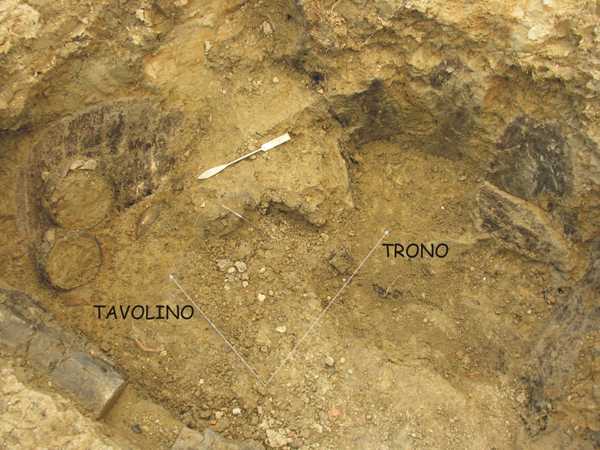 The
excavation campaign underway in Verucchio’s Necropoli Sotto la Rocca (Necropolis
under the hill) has provided finds of great importance. Six incineration tombs
are in process of exploration; five of them dolio tombs and one of the ditch
with wooden-plank cover typology. The position of the beams, descending toward
the interior of the ditch, suggested the hypothetical existence of empty burial
space over the burial. The excavation has proceeded with great care, given the
possibility of the possible finding wooden furniture characteristic of princely
tombs of the same typology.
The
excavation campaign underway in Verucchio’s Necropoli Sotto la Rocca (Necropolis
under the hill) has provided finds of great importance. Six incineration tombs
are in process of exploration; five of them dolio tombs and one of the ditch
with wooden-plank cover typology. The position of the beams, descending toward
the interior of the ditch, suggested the hypothetical existence of empty burial
space over the burial. The excavation has proceeded with great care, given the
possibility of the possible finding wooden furniture characteristic of princely
tombs of the same typology. During the last few days, this hypothesis has been confirmed. The round wooden top of a small table (tavolino), on which rested food containers, and still in vertical position, the backrest of a throne (trono), have now been revealed. However, it is now too soon to know if the throne back is decorated since it is unclear if the wood is in good enough condition for its successful retrieval and restoration. The placement of this new discovery is close to tomb B/1971, a rich warrior tomb that belonged to a member of Verucchio’s elite ruling class dating from the end of the VIII century/beginning of the VII century BCE. Many of the burial goods from this tomb now form part of the exhibition “Il Potere e la Morte” (The Power and the Death) held at the Museo di Verucchio.
The distribution of the tombs in groups ascribable to different aristocratic families has been confirmed. The importance of each member signaled by the complexity of the funerary rights and the richness of the burial goods. Masculine tombs contain arms and armor, which include bronze helmets, of which a new example has been found this year. Feminine tombs also demonstrate their importance through their burial goods such as horse-drawn carriages and many rich pieces in bronze, amber and various vases.
The archaeological team is comprised by a geomorfologist whose presence is indispensable to understand the ground-movements which have occurred in such an unstable area. The team also includes restorators from the Archaeological Superintendence, who, as had been done last year, assist in the field with the removal of particularly delicate pieces. Furthermore, a group works at the Museum under the vigilance of an archaeologist and a restorator to assess the recovered objects from a conservation point of view, undertaking preparatory conservation efforts and prioritizing further restoration work.
It is important to highlight the participation of a great number of students and recent graduates in the excavation. They come from several Italian and foreign universities, hosted in the town’s middle school by the Municipality of Verucchio. The team has been working with a complex hardware and software system provided by RayTalk Wireless International, which aids the archaeologists in collection and data analysis. This technology ranges from a wireless system covering the excavation area entirely with continuous video surveillance, transmitted live through the internet to the production of very high resolution images produced to further the scientific study of these objects.